The first-principles-based exciton theory for emergent 2D materia
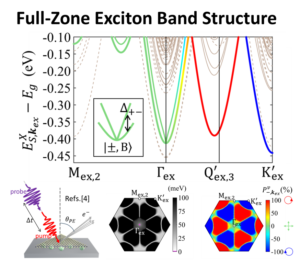
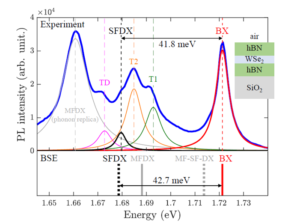
Owing to the reduced dimensionality, the weak dielectric screening in 2D materials significantly enhances the Coulomb interactions in the material, leading to the formation of tightly bound excitonic complexes such as excitons, trions, etc. Excitonic complexes are composite quasiparticles consist of few Coulomb-correlated electrons and holes, representing the many-body excited states in solid crystals. The exceedingly large binding energies of excitonic complexes make them robust even at room temperature, serving as the dominant excitation carriers governing the optical properties.
In order to study the excitonic problems in 2D materials, we developed our theory of the Bethe-Salpeter equation (BSE) and the in-house code for efficiently solving the excitonic spectra on the bases of first principles. In the past few years, with our efficient in-house computational code, we have investigated the sophisticated excitonic fine structure which consist of various bright and dark exciton states in transition-metal dichalcogenide monolayers (TMD-MLs), and extended our studies to exciton states with finite center-of-mass momenta covering the entire first Brillouin zone. Based on our previous studies, we are now extending our computational capabilities and research interests beyond single-exciton physics in 2D materials, e.g. exciton-exciton interactions, trion physics, structured light-matter interactions, Forster-type resonant energy transfer.
Selected publication:
- Guan-Hao Peng, Ping-Yuan Lo, Wei-Hua Li, Yan-Chen Huang, Yan-Hong Chen, Chi-Hsuan Lee, Chih-Kai Yang, Shun-Jen Cheng* (2019, Mar). Distinctive Signatures of the Spin- and Momentum-Forbidden Dark Exciton States in the Photoluminescence of Strained WSe2 Monolayers under Thermalization. Nano Letters, 19, 2299.
- Ping-Yuan Lo, Guan-Hao Peng, Wei-Hua Li, Yi Yang & Shun-Jen Cheng, Full-zone valley polarization landscape of finite-momentum exciton in transition metal dichalcogenide monolayers, Phys. Rev. Research 3, 043198 (2021).
- Wei-Hua Li, Jhen-Dong Lin, Ping-Yuan Lo, Guan-Hao Peng, Ching-Yu Hei, Shao-Yu Chen & Shun-Jen Cheng, The Key Role of Non-Local Screening in the Environment-Insensitive Exciton Fine Structures of Transition-Metal Dichalcogenide Monolayers, Nanomaterials 13, 1739 (2023).
Light-matter interaction between twisted light and exciton
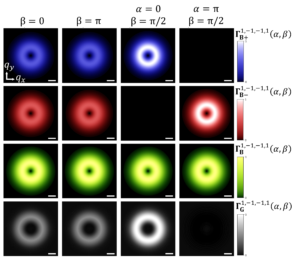
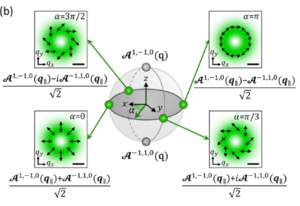
In quantum communication, quantum information is often encoded using the polarization of a photon, which corresponds to the spin angular momentum (SAM) of either +ℏ/2 (spin up) or -ℏ/2 (spin down). However, light can also be structured to carry orbital angular momentum (OAM), characterized by phase helicity in real space—resulting in what is known as Twisted Light (TL). With an unbounded OAM quantum number, TL is a powerful tool for achieving multi-dimensional quantum entanglement and high-capacity optical information transfer. When two TL beams with distinct SAM and OAM are superimposed, they form a vector vortex beam (VVB), where both the amplitude and polarization are spatially structured and entangled. This non-separable state exemplifies optical spin-orbit interaction, intricately coupling SAM and OAM and playing a crucial role in spin-orbit photonics.

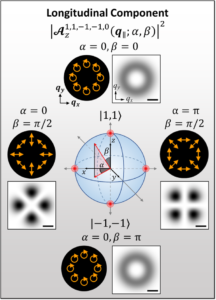
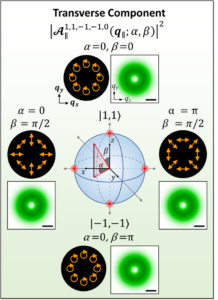
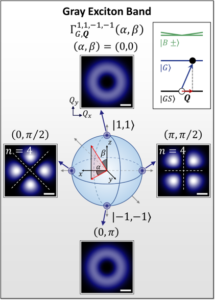
Our recent theoretical work explores the interaction between single TL beams, as well as spin-orbit-coupled VVBs, and exciton states in transition metal dichalcogenide monolayers (TMD-MLs), including both bright excitons (BXs) and gray excitons (GXs). We demonstrate that the photoexcitation of polarized TL incident on a TMD-ML results in the formation of spatially localized superpositions of finite-momentum exciton (SFME) states, encoded with OAM and SAM geometrical patterns. Additionally, we reveal that structured light, particularly TL, can significantly enhance the photoexcitation of GXs in TMD-MLs through the coupling of the longitudinal field component linked to spin-orbit interaction. Moreover, we show that a spin-orbit-coupled VVB can imprint optical information onto the optical transitions of GXs in 2D materials.
- Oscar Javier Gomez Sanchez, Guan-Hao Peng, Wei-Hua Li, Ching-Hung Shih, Chao-Hsin Chien, Shun-Jen Cheng, “Enhanced Photo-excitation and Angular-Momentum Imprint of Gray Excitons in WSe2 Monolayers by Spin–Orbit-Coupled Vector Vortex Beams”, ACS Nano 18, 17 (2024).
- GH Peng, OJG Sanchez, WH Li, PY Lo, SJ Cheng, “Tailoring the superposition of finite-momentum valley exciton states in transition-metal dichalcogenide monolayers by using polarized twisted light”, Physical Review B 106 (15), 155304 (2022).
- K. B. Simbulan, T.-D. Huang, G.-H. Peng, F. Li, O. J. G. Sanchez, J.-D. Lin, C.-I. Lu, C.-S. Yang, J. Qi, S.-J. Cheng, Ting-Hua Lu, Yann-Wen Lan, “Selective Photoexcitation of FiniteMomentum Excitons in Monolayer MoS2 by Twisted Light”, ACS Nano 15, 3481 (2021).
Effects of dielectric screening on the fine structures of exciton complexes
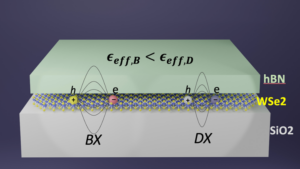
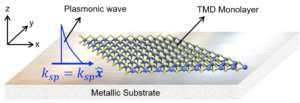
The pronounced exciton fine structures in TMD monolayers (MLs), resulting from electron-hole (e-h) exchange interaction and conduction band splitting, lead to bright exciton (BX) states with in-plane dipoles elevated by a few to tens of meV, while leaving spin-forbidden (SF) dark exciton (DX) doublets as the excitonic ground states. Within the lowest SF-DX doublet, weak intervalley exchange interaction causes valley mixing, allowing classification into a fully formed DX and a partially optically active state known as gray excitons (GXs), which have out-of-plane dipoles. GXs combine the long lifetime of DXs with the brightness of BXs. However, optically and selectively accessing GX states remains challenging, making near-field interactions a promising method. The near-field generated by surface plasmons (SPs), with its out-of-plane components, can facilitate these interactions.